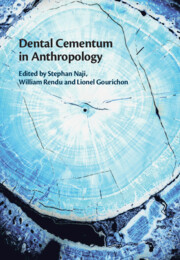Book contents
- Dental Cementum in Anthropology
- Dental Cementum in Anthropology
- Copyright page
- Dedication
- Contents
- Contributors
- Foreword
- Introduction: Cementochronology in Chronobiology
- Part I The Biology of Cementum
- Part II Protocols
- Part III Applications
- 17 Using Cementochronology to Discuss the Organization of Past Neanderthal Societies
- 18 Investigating Seasonal Competition between Hominins and Cave Hyaenas in the Belgian Ardennes during the Late Pleistocene: Insights from Cementum Analyses
- 19 Cementochronology to the Rescue: Osteobiography of a Middle Woodland Woman with a Combined Skeletal Dysplasia
- 20 Estimating a Mortality Profile of Fisher-Gatherers in Brazil Using Cementochronology
- 21 Cementochronology: A Solution to Reconstructing Past Populations’ Mortality Profiles Using Individual Age-at-Death Estimates
- 22 Assessing Age-Related Mortality at Petra, Jordan, Using Cementochronology and Hazard Modeling
- 23 Shaping Age-at-Death Distributions by Applying Tooth Cementum Analysis to the Early Medieval Graveyard of Lauchheim (Germany)
- 24 Back to the Root: The Coming of Age of Cementochronology
- Index
- Plate Section (PDF Only)
- References
22 - Assessing Age-Related Mortality at Petra, Jordan, Using Cementochronology and Hazard Modeling
from Part III - Applications
Published online by Cambridge University Press: 20 January 2022
- Dental Cementum in Anthropology
- Dental Cementum in Anthropology
- Copyright page
- Dedication
- Contents
- Contributors
- Foreword
- Introduction: Cementochronology in Chronobiology
- Part I The Biology of Cementum
- Part II Protocols
- Part III Applications
- 17 Using Cementochronology to Discuss the Organization of Past Neanderthal Societies
- 18 Investigating Seasonal Competition between Hominins and Cave Hyaenas in the Belgian Ardennes during the Late Pleistocene: Insights from Cementum Analyses
- 19 Cementochronology to the Rescue: Osteobiography of a Middle Woodland Woman with a Combined Skeletal Dysplasia
- 20 Estimating a Mortality Profile of Fisher-Gatherers in Brazil Using Cementochronology
- 21 Cementochronology: A Solution to Reconstructing Past Populations’ Mortality Profiles Using Individual Age-at-Death Estimates
- 22 Assessing Age-Related Mortality at Petra, Jordan, Using Cementochronology and Hazard Modeling
- 23 Shaping Age-at-Death Distributions by Applying Tooth Cementum Analysis to the Early Medieval Graveyard of Lauchheim (Germany)
- 24 Back to the Root: The Coming of Age of Cementochronology
- Index
- Plate Section (PDF Only)
- References
Summary
Age-at-death mortality profiles provide an important supplementary record of mortality risks that archaeological populations faced. We use hazard modeling to calculate the risk of death by age for adults to establish a mortality profile for the Petra North Ridge sample. Age-at-death estimates were generated using cementochronology from 66 individuals, which not only provides more accurate age estimates but increases our sample size due to the fragmented and commingled nature of the Petra assemblage. Our results indicate that the mortality profile from Petra resembles that of an attritional sample. The regional and local political-economic, physical and social environments resulted in age-specific mortality risks lower than that typically expected for an ancient, urban population and potentially reflected immigration of young adults into Petra.
Keywords
- Type
- Chapter
- Information
- Dental Cementum in Anthropology , pp. 351 - 363Publisher: Cambridge University PressPrint publication year: 2022



